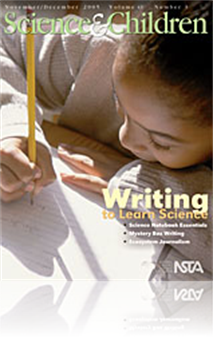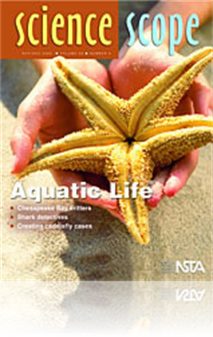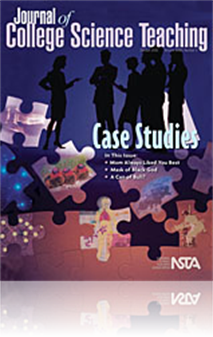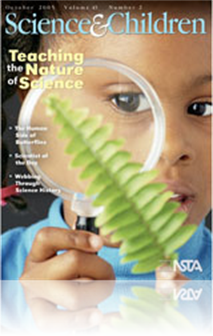All Resources
Journal Article
Five Good Reasons to Use Science Notebooks
Science notebooks are an everyday part of learning in the Tucson (AZ) Unified School District. K-8 schools there have begun using notebooks in conjunction with their kit-based science program. In this article an elementary school shares its journey...
Journal Article
Chesapeake Bay Critters: Up Close and Personal
Shed light on the integral part of the Chesapeake Bay watershed by implementing this hands-on, inquiry- based unit on the Chesapeake Bay watershed. The goals of this unit are to teach students about the bay, its watershed, the organisms that live the...
Journal Article
Commentary: Interdisciplinary Does Not Mean Intimidating
According to the author of this month's Commentary column, "Interdisciplinary units are not superhuman feats, but natural extensions of good teaching practice and conversations among colleagues." She recounts how her thinking in regards to interdisci...
Journal Article
Third-grade students display their understanding of life science concepts by creating an imaginative newspaper. This creative writing project engages students in researching, writing, and editing a newspaper based on a prairie ecosystem....
Journal Article
Science Sampler: Creating caddisfly cases
The larval stage of a northern casemaker caddisfly provides a creative hands-on activity for students while also introducing them to aquatic insect development and adaptations to stream life. This project is an opportunity to study the role of this i...
Journal Article
Exploring New Environments, a half-day workshop developed by the University of North Carolina at Chapel Hill's DESTINY Traveling Science Learning Program, takes an interdisciplinary approach to teacher professional development. This model was created...
Journal Article
Favorite Demonstration: MOS -- The Critical Elements of Doing Effective Classroom Demonstrations
There is a wealth of evidence showing that students can remember many of their science class demonstrations for countless years. This is a good testimony to the emotional impact of demonstrations. One way to make them into an effective teaching str...
Journal Article
Methods and Strategies: Journals of Discovery
Integrated science journals provide educators with valuable insight into teaching. They allow students to reflect on how engaged they were in learning about a particular topic while also providing information about how successful the teacher was in ...
Journal Article
Society for College Science Teachers: Is Academic Freedom a Threat to Teaching Introductory Science?
As academics we value different viewpoints, the right and need to pursue scholarly interests, and the importance of discussing controversial topics as a means of engaging students, promoting critical thinking, and helping students mature intellectual...
Journal Article
Editor's Note (November/December 2005)
Scientists write in many ways as they develop and share what they do. It only makes sense that our students do as well. This issue presents ideas for using writing to create purpose in science class....
Journal Article
Tried and True: It's a gas! An exploration of the physical nature of gases
Gases present something of a paradox for the casual observer--they are everywhere and yet, it remains difficult to see them anywhere. This instructional sequence engages middle school students in the inquiry process, enabling them to develop more rob...
Journal Article
Making the Grounds of Scientific Inquiry Visible in the Classroom
The ability to formulate questions is a critical skill that forms the basis of scientific inquiry. Questioning is indeed robustly rooted in children's everyday ways of thinking about the world, but serious classroom support is required if these child...
Journal Article
The ESA21 Project: A Model for Civic Engagement
Making the content of a course interesting to students can be quite a challenge for an instructor. Making the content of a required general education science course interesting to nonscience majors can be near to impossible. A lack of interest in a s...
Journal Article
Yikes! There is fungus among us! Your middle school students will enjoy this role-playing simulation that's designed to help teach them about the typical lifecycle of a fungus. Students assume the roles of fungi, spores, living and dead organisms, ba...
Journal Article
Changing the Learning Environment in Large General Education Astronomy Classes
The gradual, ongoing transformation of a large general education astronomy class is presented. Emphasis is on student reaction to and academic impact of changes in the teaching/learning environment introduced over a five-year period. In-class, cooper...
Journal Article
Teacher's Toolkit: Reforming cookbook labs
The majority of ancillary materials provided with any textbook includes a large quantity of labs that have step-by-step instructions. Although it is important in science for students to learn how to follow directions, offering only cookbook labs limi...
Journal Article
A Message from the NSTA President: A New Era for NSTA Conventions
NSTA has unveiled a new name--and an enriched format--for its time-honored conventions. The NSTA national and area conventions will now be called NSTA Conferences on Science Education. Teachers will benefit from the wealth of information contained in...
Journal Article
Case Study: The Business End of Cases
This article takes a retrospective look at how the folks in business schools look at the case method. The legacy of cases in business may seem short in the eyes of some but it is positively ancient when compared to the use of the case study in the s...
Journal Article
Developing writing skills along with content by incorporating hands-on science experiences and related writing lessons provides students with a purpose for writing, which makes it more meaningful to students. The Mystery Box lesson discussed in this...
Journal Article
A Message from the NSTA President: A New Era for NSTA Conventions
NSTA has unveiled a new name--and an enriched format--for its time-honored conventions. The NSTA national and area conventions will now be called NSTA Conferences on Science Education. Teachers will benefit from the wealth of information contained in...
Journal Article
Cemeteries can be outdoor museums, teeming with valuable information that tells a story. They provide archaeologists with an opportunity to examine how artifacts (tombstones and monuments) reflect cultural change and how societies differ from one ano...
Journal Article
This article focuses on the effective components of student science notebooks and their use as an effective teaching tool to assist students in developing a deeper understanding of science content....
Journal Article
A Killer Lake Alive with Learning Opportunities
Students often fail to remember, understand, and apply what they have learned in science classrooms. The sample lesson described in this article illustrates how teachers might move science education toward an authentic, engaging process that excites ...
Journal Article
Idea Bank - Bromothymol Blue: The Demo We All Do!
Often science teachers perform demonstrations only to discover that students have already seen the experiment in a previous course. Teachers should take advantage of these opportunities to showcase the interconnectedness of different science discipli...
Journal Article
Editorial: No Time for Complacency
What accounts for our citizens' apparent lack of interest in scientific careers? The National Science Foundation (NSF) and other agencies have pumped tens of billions into science education improvement at all levels, and while there is still much ro...
Journal Article
Laboratory Based Case Studies: Closer to the Real World
Case-based laboratories offer students the chance to approximate real science. Based on interesting stories that pose problems requiring experimental solutions, they avoid the cookbook approach characteristic of traditional undergraduate laboratory i...
Journal Article
PCBs in the Last Frontier: A Case Study on the Scientific Method
This interrupted case study is based on current research involving the global transport of polychlorinated biphenyls (PCBs). Students are asked to propose several hypotheses and experiments in an attempt to determine how PCBs are transferred globally...
Journal Article
The Early Years: More than Messing Around with Magnets
This article focuses on magnets and teaching the nature of science. The predicting and testing students do in this month's activity also relate to Science and Children's theme in this issue, teaching the nature of science....
Journal Article
Scope on Safety: All about asbestos
Asbestos has been used in the construction of elementary, middle, and high school ceilings, floor tile adhesives, pipe and structural beam insulations, science laboratory benches, wire gauss on ring stands, fume hood panels, general insulation, and m...
Journal Article
This special issue of JCST once again features a set of articles on the use of case studies in science assembled by Clyde (Kipp) Herreid, Distinguished Teaching Professor at the University at Buffalo, State University of New York. As a result of Kip...
Journal Article
The Case of the Druid Dracula: A Directed "Clicker" Case Study on DNA Fingerprinting
This article describes how case studies have been successfully implemented in an introductory biology course of 300+ students using available technologies ranging from WebCT, used to assign students to permanent small groups (as well as assign groups...
Journal Article
In 1986, Lake Nyos, a volcanic lake in Cameroon, released a huge amount of carbon dioxide gas, killing over 1,700 people in the surrounding area. This case study, developed for use in a limnology or aquatic biology course, explores that event, introd...
Journal Article
Ask the Experts -- October 2005
The Experts tackle the question, "What is the underlying natural phenomenon that causes the natural log function to show up so frequently in scientific equations? and "Why do some hairs on the human body grow indefinitely while others grow to a certa...
Journal Article
Step-by-step instructions in the chemistry lab often eliminate opportunities for inquiry, higher levels of thinking, and the sense of accomplishment students find through independent discovery. However, removing procedures from chemistry labs creates...
Journal Article
Artificial Sanity: A Case Study for a Class in Introductory Psychology
Using the story of death row inmate Charles Singleton, who developed paranoid schizophrenia while in prison awaiting execution, this case study explores the relationship between a society’s concept of mental illness and its treatment of people who ...
Journal Article
Inquiry, Science Workshop Style
Few people are more curious about their worlds than young children. In many published programs, lessons revolve around set questions, with step-by-step directions provided for children to follow. This approach seems to say that young children are n...
Journal Article
Science Shorts: Nature of Science Is...
The phrase “nature of science” refers to the characteristics of scientific knowledge that necessarily result from the scientific investigations that scientists conduct to develop knowledge. Yet, these characteristics are assumed by many to be “...
Journal Article
Igniting Girl's Interest in Science Careers
Since leaving the National Aeronautics and Space Administration (NASA), a passion of Sally Ride's has been to find ways to keep girls interested in science. Recently, Sally Ride Science and NASA teamed up to produce a poster based on the book titled,...
Journal Article
Science Sampler: Out of the Stone Age
A collection of rocks and minerals can bring out the little kid in middle school students. When they walk into the classroom and see all of the rocks, their curiosity is sparked. They hurry over to the table and pick up each rock with childlike glee....
Journal Article
Career of the Month: An Interview with Sport Biomechanist Bill Sands
This month's column features Bill Sands, a Sports Biomechanist at the U.S. Olympic Training Center (OTC). As Head of Sport Biomechanics and Engineering, he helps Olympic athletes defeat their opponents and achieve their dreams. Catapult your students...












